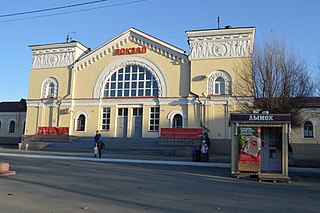
Chelyabinsk Oblast is a federal subject of Russia in the Ural Mountains region, on the border of Europe and Asia. Its administrative center is the city of Chelyabinsk.

Ural Economic Region is one of twelve economic regions of Russia. This prominent industrial region consists of the following subdivisions : Bashkortostan (Ufa), Chelyabinsk Oblast (Chelyabinsk), Kurgan Oblast (Kurgan), Orenburg Oblast (Orenburg), Perm Krai (Perm), Sverdlovsk Oblast (Yekaterinburg) and Udmurt Republic (Izhevsk). It is mostly located in the Central, and partly in the Southern and Northern parts of the Urals, but also includes parts of the East European and West Siberian Plains. Its extent is different from that of the Ural Federal District; Bashkortostan, Orenburg Oblast, Perm Krai and Udmurtia are in the Volga Federal District while the other three are in the Ural Federal District.

Novotroitsk is a town in Orenburg Oblast, Russia, located on the right bank of and along the Ural River, 276 kilometers (171 mi) from Orenburg, on the border with Kazakhstan. In the east Novotroitsk almost borders Orsk: the distance between the two cities is less than 2 kilometers (1.2 mi). Population: 98,173 (2010 Russian census); 106,315 (2002 Census); 106,084 (1989 Soviet census).

Kamensk-Uralsky is a city in Sverdlovsk Oblast, Russia, located at the confluence of the Kamenka and Iset Rivers. Population: 174,689 (2010 Russian census); 186,153 (2002 Census); 207,780 (1989 Soviet census); 173,000 (1972); 51,000 (1939).
George Sachs was a Russian-born German and American metallurgist.
Metalloinvest Management Company LLC is a Russian mining and metallurgy company specializing in the manufacture of steel. It was founded in 1999 and is composed of a mining division and a steel division. USM Holdings Business Development owns 100% of Metalloinvest JSC. Alisher Usmanov is the major beneficiary of USM Holdings (60%), with other major beneficiaries — the companies of Andrei Skoch and Farhad Moshiri — owning 30% and 10%, respectively.

Iskander Kakhramonovich Makhmudov is an Uzbek-born Russian businessman.

"TMK" is a leading global manufacturer and supplier of steel pipes, tubular solutions and related services for the oil and gas industry, and specialty tubular products and pipeline systems for the nuclear, chemical, mechanical engineering and construction industries. Currently, the company integrates production assets in Russia, Kazakhstan, Romania and Czech Republic. and two R&D centers in Russia. Headquarters – Moscow (Russia).
The mineral industry of Russia is one of the world's leading mineral industries and accounts for a large percentage of the Commonwealth of Independent States' production of a range of mineral products, including metals, industrial minerals, and mineral fuels. In 2005, Russia ranked among the leading world producers or was a significant producer of a vast range of mineral commodities, including aluminum, arsenic, cement, copper, magnesium compounds and metals, nitrogen, palladium, silicon, nickel and vanadium.

Kamensk-Uralsky Metallurgical Works J.S.Co. (KUMZ) is one of the town-forming enterprises of Kamensk-Uralsky, Sverdlovsk Oblast, Russia. KUMZ was founded especially for supplying of aerospace industry with semi-finished products in aluminium and magnesium alloys. Currently, the plant produces aluminium alloy billets, forged and rolled plates, roll bond heat exchangers, extruded rods, bars, tubes, drill pipes, profiles, die-forgings.
Carlton Forge Works is an aerospace manufacturing company that produces seamless rolled rings. Carlton was found in 1929 and was privately held. According to Manta and Business Week, the company has about 250-300 employees. The company was previously owned by Allan Carlton.

Pyotr Fadeyevich Lomako was a Soviet politician and economist, head of Gosplan between 1962 and 1965. During the Second World War, he was responsible for overseeing the evacuation of Soviet industry to the Ural Mountains region. He was a seven-time recipient of the Order of Lenin, and also received the golden medal of the Hero of Socialist Labour.

Ural Mining and Metallurgical Company is a Russian metallurgical company based in Verkhnyaya Pyshma. It is the second largest copper producer in Russia.

The food industry of Russia is a branch of industry in Russia.

The All-Russian Institute of Light Alloys, formerly the Vils Scientific Production Association is a company based in Moscow, Russia. Rostec is the largest shareholder, controlling 39% of the institute.

The Rail Bridge over the Iset River - is an experimental bridge over the Iset River is a unique engineering structure made according to the advanced technology of the late 1930s in Kamensk-Uralsky, Sverdlovsk oblast.
The metallurgical production of the Republic of Azerbaijan is considered high due to the large deposits of alunite, polymetallic ores, deposits of iron ore, etc. The metallurgy industry of Azerbaijan encompasses both ferrous and non-ferrous branches.

The history of metallurgy in the Urals stands out to historians and economists as a separate stage in the history of Russian industry and covers the period from the 4th millennium BC to the present day. The emergence of the mining district is connected with the history of Ural metallurgy. The geography of the Ural metallurgy covers the territories of modern Perm Krai, Sverdlovsk Oblast, Udmurtia, Bashkortostan, Chelyabinsk Oblast and Orenburg Oblast.
Serafim Kolpakov was a Soviet engineer who served as minister of metallurgy in the 1980s. He was a member of the central committee of the Soviet Communist Party.













